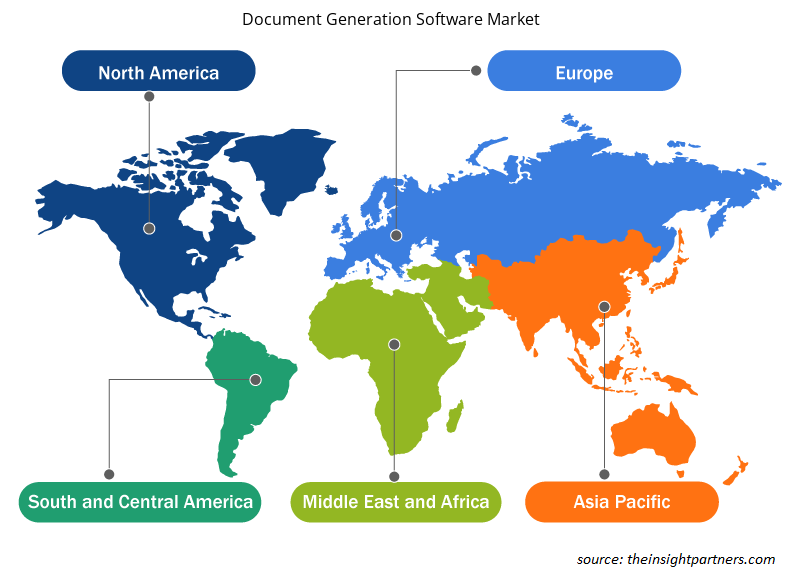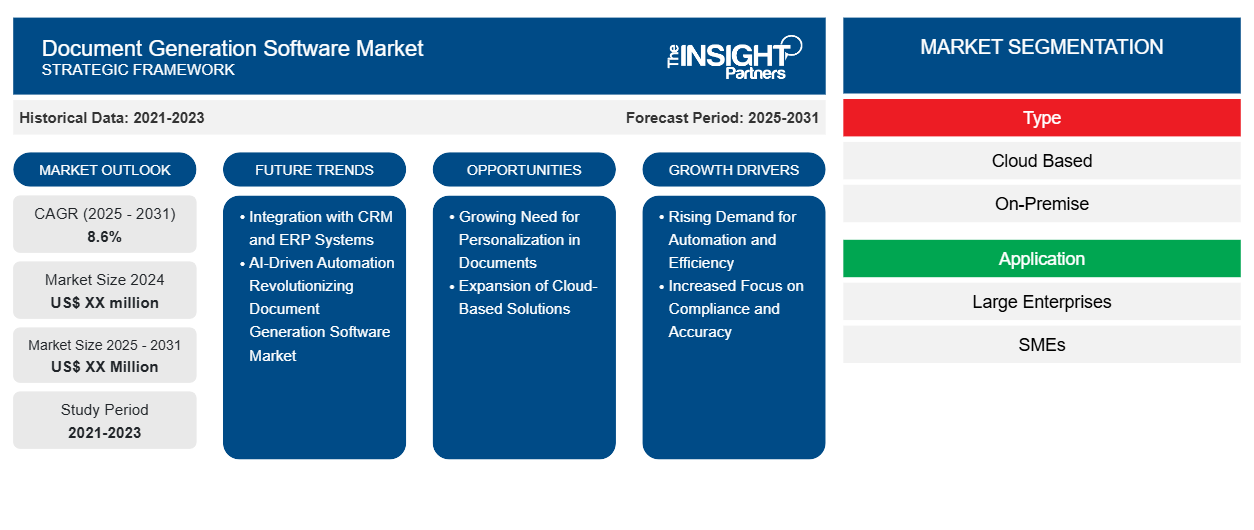预计文档生成软件市场在 2023 年至 2031 年期间的复合年增长率为8.6%,市场规模将从 2023 年的 XX 百万美元扩大到 2031 年的 XX 百万美元。
报告按类型(基于云、本地)和应用(大型企业、中小企业)进行细分。全球分析进一步细分为区域和主要国家。报告以美元为单位提供上述分析和细分的价值。
报告目的
Insight Partners 发布的《文档生成软件市场》报告旨在描述当前形势和未来增长、主要驱动因素、挑战和机遇。这将为各种业务利益相关者提供见解,例如:
- 技术提供商/制造商:了解不断变化的市场动态并了解潜在的增长机会,从而能够做出明智的战略决策。
- 投资者:对市场增长率、市场财务预测以及整个价值链中存在的机会进行全面的趋势分析。
- 监管机构:监管市场政策和警察活动,旨在最大限度地减少滥用行为,维护投资者的信任和信心,维护市场的完整性和稳定性。
文档生成软件市场细分
类型
- 基于云
- 本地部署
应用
- 大型企业
- 中小企业
定制此报告以满足您的需求
您可以免费定制任何报告,包括本报告的部分内容、国家级分析、Excel 数据包,以及为初创企业和大学提供优惠和折扣
- 获取此报告的关键市场趋势。这个免费样品将包括数据分析,从市场趋势到估计和预测。
文档生成软件市场增长动力
- 自动化和效率需求不断增长:随着全球企业不断实施数字化,对自动化工具的需求也在不断增长,以便通过减少人工来提高效率。通过将模板与来自众多来源的数据合并,文档生成软件可以自动化生成文档的过程,从而节省手动创建此类文档所需的时间和精力。这有助于组织实现其最终目标,即高生产力、节省运营成本以及一致且准确地生成文档,而这些目标都要求有此类软件。
- 更加注重合规性和准确性:对金融、医疗保健和法律服务依赖程度较高的行业必须在文档编制过程中高度重视合规性和准确性。该软件通过现成的模板和实时数据可用性帮助公司完全合规且无错误。无错误且合规的文档生成功能是驱动因素之一,尤其是对于合规性和审计密集型组织而言。
文档生成软件市场未来趋势
- 与 CRM 和 ERP 系统集成:生成文档的软件与企业中的 CRM 和 ERP 系统集成的主要原因之一。此类集成允许用户通过直接自动填充将客户、销售和财务数据导入这些模板,从而减少时间并降低人为错误可能带来的风险。对于希望简化工作流程并提高部门间数据一致性的企业来说,这种集成使文档生成软件成为更具吸引力的工具。
- 人工智能驱动的自动化彻底改变了文档生成软件市场:由于人工智能和机器学习的进步,文档生成软件市场正在快速增长。人工智能驱动的自动化将简化文档创建、减少错误并增强个性化。随着企业对更快、更高效的文档工作流程的需求,这些智能解决方案将提高生产力、改善合规性并实现更好的文档管理,从而重塑法律、金融和医疗保健等行业。
文档生成软件市场机会
- 文档个性化需求日益增长:大多数行业都需要个性化文档来满足个人客户的需求。例如,在销售和营销方面,公司通常需要为不同的客户生成个性化的提案或合同。文档生成软件可帮助企业创建集成客户特定数据的定制文档,确保个性化方法可提高客户满意度和参与度。能够轻松大规模生成个性化文档是市场的主要驱动力之一。
- 基于云的解决方案的扩展:所有行业对基于云的解决方案的需求都在增长,文档生成软件市场也不例外。基于云的文档生成工具非常适合远程工作环境,因为它们为企业提供了远程生成文档、实时协作和从任何位置访问文档的灵活性。云解决方案还减少了企业在昂贵基础设施上的投资,可扩展的即用即付模式使各种规模的企业都能够更轻松地生成文档。
文档生成软件市场区域洞察
Insight Partners 的分析师已详细解释了预测期内影响文档生成软件市场的区域趋势和因素。本节还讨论了北美、欧洲、亚太地区、中东和非洲以及南美和中美洲的文档生成软件市场细分和地理位置。

- 获取文档生成软件市场的区域特定数据
文档生成软件市场报告范围
| 报告属性 | 细节 |
|---|---|
| 2023 年的市场规模 | XX 百万美元 |
| 2031 年市场规模 | XX 百万美元 |
| 全球复合年增长率(2023 - 2031)CAGR (2023 - 2031) | 8.6% |
| 史料 | 2021-2022 |
| 预测期 | 2024-2031 |
| 涵盖的领域 | 按类型
|
| 覆盖地区和国家 | 北美
|
| 市场领导者和主要公司简介 |
|
文档生成软件市场参与者密度:了解其对业务动态的影响
文档生成软件市场正在快速增长,这得益于最终用户需求的不断增长,而这些需求又源于消费者偏好的不断变化、技术进步以及对产品优势的认识不断提高等因素。随着需求的增加,企业正在扩大其产品范围,进行创新以满足消费者的需求,并利用新兴趋势,从而进一步推动市场增长。
市场参与者密度是指在特定市场或行业内运营的企业或公司的分布情况。它表明在给定市场空间中,相对于其规模或总市场价值,有多少竞争对手(市场参与者)存在。
在文档生成软件市场运营的主要公司有:
- ABBYY 软件
- Adobe 系统
- 佳能公司
- Capsys 公司
- EMC 公司
免责声明:上面列出的公司没有按照任何特定顺序排列。

- 获取文档生成软件市场顶级关键参与者概览
主要卖点
- 全面覆盖:报告全面涵盖了文档生成软件市场的产品、服务、类型和最终用户的分析,提供了整体概况。
- 专家分析:报告基于对行业专家和分析师的深入了解而编写。
- 最新信息:该报告涵盖了最新信息和数据趋势,确保了其与业务的相关性。
- 定制选项:此报告可以定制以满足特定客户要求并恰当地适应业务策略。
因此,文档生成软件市场研究报告有助于引领解读和了解行业情景和增长前景。尽管可能存在一些合理的担忧,但本报告的总体优势往往大于劣势。
- 历史分析(2 年)、基准年、预测(7 年)及复合年增长率
- PEST和SWOT分析
- 市场规模、价值/数量 - 全球、区域、国家
- 行业和竞争格局
- Excel 数据集
近期报告
相关报告
客户评价
购买理由
- 明智的决策
- 了解市场动态
- 竞争分析
- 客户洞察
- 市场预测
- 风险规避
- 战略规划
- 投资论证
- 识别新兴市场
- 优化营销策略
- 提升运营效率
- 顺应监管趋势





















 获取免费样品 - 文档生成软件市场
获取免费样品 - 文档生成软件市场